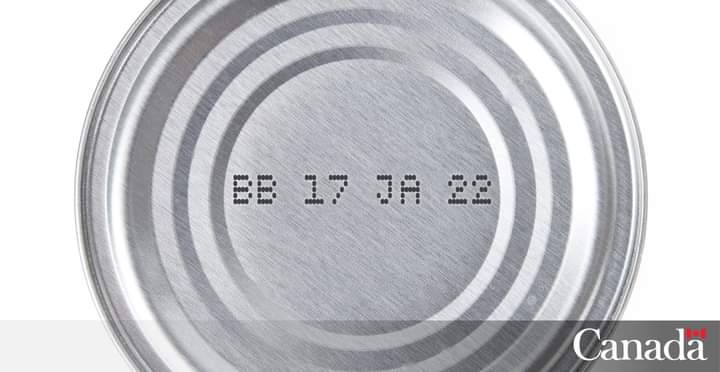**** Info via Health Canada
Date labelling on pre-packaged foods
Information about dates on pre-packaged food is a valuable source of information for consumers.
A basic understanding of what terms are used can help you to better understand these labels.
There are different kinds of date markings, depending on the product. The most common terms are “best-before” dates, “packaged on” dates, and expiration dates. Knowing what these terms mean will help you understand the labels, which in turn will help you make informed choices about the food you buy.
“Best-before” date
A “best-before” date, also known as a durable life date, tells you when the durable life period of a prepackaged food ends.
Durable life means the anticipated amount of time that an unopened food product, when stored under appropriate conditions, will retain its:
- freshness,
- taste,
- nutritional value, or
- any other qualities claimed by the manufacturer.
This information is usually found on the label with the words “best before” and “meilleur avant“.
The best-before date indicates to consumers that if the product has been properly handled (stored under conditions appropriate to that product), the unopened product should be of high quality until the specified date.
Best-before dates do not guarantee product safety. However, they do give you information about the freshness and potential shelf-life of the unopened foods you are buying.
It is important to note that a best-before date is not the same as an expiration date.
Packaging dates
“Packaged on” dates are similar to “best-before” date but are used on retail-packed foods with a durable life date of 90 days or less, and must be accompanied by durable life information either on the label or on a poster next to the food. The durable life information can be expressed several ways, for example, the number of days a product will retain its freshness, or a best-before date. Together, the “packaged on” date and durable life information tell consumers about the anticipated amount of time that an unopened food product will retain its quality and freshness.
Expiration date
An expiration date is not the same as a best-before date. Expiration dates are required only on certain foods that have strict compositional and nutritional specifications which might not be met after the expiration date.
Expiration dates must be used on the following products:
- formulated liquid diets (nutritionally complete diets for people using oral or tube feeding methods)
- foods represented for use in a very low-energy diet (foods sold only by a pharmacist and only with a written order from a physician)
- meal replacements (formulated food that, by itself, can replace one or more daily meals)
- nutritional supplements (food sold or represented as a supplement to a diet that may be inadequate in energy and essential nutrients)
- human milk substitutes (infant formula)
After the expiration date, the food may not have the same nutrient content declared as on the label.
Food should not be bought, sold or eaten if the expiration date has passed. It should be discarded.
Other date markings
The Food and Drug Regulations state the terms “use by” and “employez avant” may replace “best before” for prepackaged fresh yeast only. It must be presented in the same form and manner as the best-before date.
Other voluntary date marking systems may be useful to consumers. These may appear on food products as long as they are not misleading and the label meets appropriate requirements. These include:
- “sell by” dates
- “prepared on” dates
- “freeze by” dates
- “manufactured on” dates
Foods on which best before dates should appear
Foods that will keep fresh for 90 days or less, and are packaged at a place other than the retail store, from which they are sold, must have the following on the label:
- a best-before date, and
- proper storage instructions (if different from normal room temperature).
Foods that will keep fresh for 90 days or less, and are packaged at the retail store, from which they are sold, may be labelled with either:
- a best-before date and storage instructions, or
- a “packaged on” date with accompanying information about the durable life of the food (such as the number of days a product will retain its freshness) on the label or on a poster next to the food.
If consumers want more information about food packaged at the retail store, such as the “packaged on” date, they can ask the retailer for this information.
Determining the durable life
It is the responsibility of the manufacturer or retailer to determine:
- if the product has a durable life of 90 days or less, and
- the specific durable life information for the products they sell.
Food producers and retailers that manufacture food products base the date on how long an unopened product will retain its wholesomeness, taste, nutritional value, and any other qualities, as well as other factors such as the type of product, how it is processed and how it is packaged and stored.
The durable life of products or categories is not set out in regulations.
Best-before dates on products with a shelf life greater than 90 days
Foods with an anticipated shelf life greater than 90 days are not required to be labelled with a best-before date or storage information. This is because these foods are generally considered to be shelf stable. Examples include most canned foods, many dry foods such as pasta and foods that are sold in a frozen state.
If manufacturers and retailers choose to provide customers with this information, they must follow the required manner of declaration (see the next section).
How a best-before is shown on a label
The best-before date must be identified using the words “best before” and “meilleur avant” grouped together with the date, unless a clear explanation of the significance of the best-before date appears elsewhere on the label. Similarly, packaged-on dates must also be grouped together with the date, using the words “packaged on” and “empaqueté le“.
The best-before date may appear anywhere on the package. If it is placed on the bottom, this has to be indicated elsewhere on the label.
The month must be in both official languages or indicated by using specified bilingual symbols.
The year is optional, unless it is needed for the sake of clarity (for example, if the shelf life extends into a new calendar year). If included, the year must appear first, followed by the month, then the day.
Example:
Best before
17 JA 30
Meilleur avant
- JA: January
- FE: February
- MR: March
- AL: April
- MA: May
- JN: June
- JL: July
- AU: August
- SE: September
- OC: October
- NO: November
- DE: December
Food safety once a food has passed the best-before date
Best-before dates are not indicators of food safety, neither before nor after the date.
You can buy and eat foods after the best-before date has passed. However, when this date has passed, the food may lose some of its freshness and flavour, or its texture may have changed. Some of its nutritional value may be lost. For example, vitamin C content in juice.
Best-before dates apply to unopened products only. Once opened, the food’s shelf life may change.
Foods that are likely to spoil should be properly stored, and they should be eaten as quickly as possible. Harmful micro-organisms that lead to foodborne illness can grow in foods, even if they do not appear to be spoiled. Storing your food properly is one of the key things you can do to protect yourself and your family from foodborne illness.
Selling foods that are past the best-before dates
It is not illegal to sell a product if its best-before date has passed. However, when this date has passed, the food may lose some of its freshness and flavour, or its texture may have changed. Some of its nutritional value, such as vitamin C content, may also be lost.
Changing the best-before dates on food
It is illegal to sell food that is unsafe. It is the responsibility of food manufacturers, producers and retailers to ensure the food they produce and sell is safe.
Any changes made to the best-before date or durable life information that result in false or misleading information on the label are prohibited by Section 5.(1) of the Food and Drugs Act.
What to do if you see a product for sale that has passed the best-before date
As it is not illegal to sell a product that is past its best-before date, a consumer can use this information to consider how the food may have changed in terms of its freshness, flavour, texture and/or nutritional value before purchasing. Alternatively, a consumer may notify the retailer.
What to do if you see a product for sale that has passed the expiration date
You should report a concern to the CFIA if you want to lodge a complaint about a specific food product that you think does not meet regulatory requirements. This allows an inspector to begin an investigation that is in accordance with the CFIA‘s inspection and compliance principles.
The Government of Canada’s role in food safety
The Government of Canada is committed to food safety.
Health Canada establishes regulations and standards relating to the safety and nutritional quality of food sold in Canada. Through inspection and enforcement activities, the CFIA is responsible for verifying that food sold in Canada meets Health Canada’s requirements.
For more information on food safety, please visit




